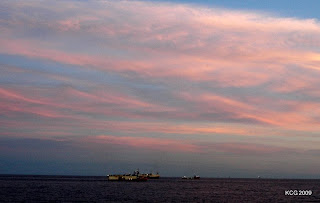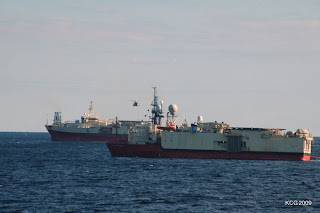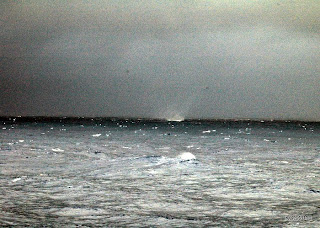My hotel room in Houston...a little comfort before heading out to sea for 5 weeks
Our last opportunity for a drink before heading offshore...the bar/restaurant in the hotel
The following morning we were picked up for the hour and a half busride to Galveston. It was a very quiet bus ride as most of us were still sleepy from a seemingly too-short night's sleep (or too late with too many drinks!). Upon arriving at the port we were escorted to the awaiting transfer boat and then taken on the 20 minute ride out to the Harrier Explorer which was at anchor just outside the port. Normally the Harrier Explorer and the other vessels continue doing survey work, about 80 miles off the coast, while crew transfers occur via helicopter but the ship came in due to heavy seas so we did not go by helicopter this time. Once we were onboard we received our handover information from the crew we were replacing, which inlcuded my fellow whale nerd friend Jacklyn Barrs (we won't be seeing each other for about 6 months because we are on exactly opposite rotations for this job :-( , and received our cabin assignments. We had a ship's safety and orientation tour, during which I had a my first sighting...a group of bottlenose dolphins were swimming alongside the ship just as it was getting underway. We would not be arriving at the prospect until the next morning so myself and the other two MMOs had time to settle into our cabins, catch up on sleep and adjust to the motion of the ship.
During our transfer to the prospect we began ancillary MMO watches during which time our lead MMO spotted a group of pilot whales about 300 meters off the ship. Unfortunately myself and the other MMO reached the bridge too late to see the whales :-( After arriving on the prospect we began our full schedule of watches to: ensure no marine mammals were within 500 meters of the airguns during the half hour prior to their startup, to ensure the seismic crew use a soft start (gradaully increase their power) to reach full power for operations to begin, and to watch for marine mammals during all daylight hours to ensure none are within 500 meters of the guns while they are operating. Should a whale be sighted within 500 meters of the airguns under power our job was to inform the seismic crew to shut the guns down until half an hour after the animals are last seen. The guidelines we use to advise for seismic mitigation in the Gulf of Mexico are set by the United States Interior Minerals Management Service and is the Notice To Leasees (NTL) Implementation of Seismic Survey Mitigation Measures and Protected Species Observer Program.
Following are some photos from this survey. As you'll see the sky, sunrises and sunsets are quite spectacular offshore in the Gulf of Mexico and since we saw very few marine mammals I ended up taking many photos of the ships and skies.
This was an awesome cloud formation
The FRC on the Harrier Explorer
4 of the 7 ships operating in the survey
Oil rigs on the Gulf of Mexico horizon
Gorgeous sunset
Trying to get the green flash as the sun dropped below the horizon. No luck, but still very nice colours.
Sunrise skies
Another sunset
Helicopter transferring crew to and from one of the other ships
The clouds really add to the skies
On the starboard bridge wing...this is where we observed from during decent weather
Not so calm seas!
I was playing with contrast here...you can see the white blotch in the centre where a seaspout had started forming
My cabin, I got very lucky as it was a very comfortable size
And my cabin was quite sunny too...I even started growing a little plant on the porthole window sill!




















Thanks for the pictures and blog. I'm joining the boat for the first time soon so it's good to see it is a comfortable ship.
ReplyDelete